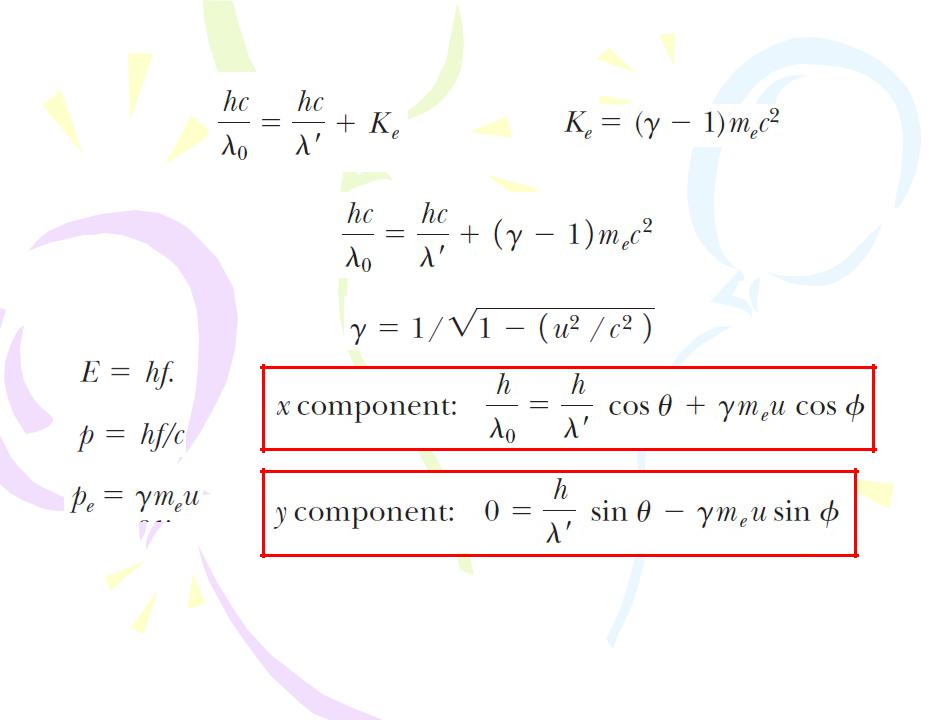
- •Course of lectures «Contemporary Physics: Part2»
- •Einstein’s special theory of relativity when dealing with particle speeds comparable to the
- •As physicists sought new ways to solve these puzzles, another revolution took place
- •Blackbody Radiation and Planck’s Hypothesis
- •Blackbody Radiation and Planck’s Hypothesis
- •Blackbody Radiation and Planck’s Hypothesis
- •Blackbody Radiation and Planck’s Hypothesis
- •Blackbody Radiation and Planck’s Hypothesis
- •Blackbody Radiation and Planck’s Hypothesis
- •Blackbody Radiation and Planck’s Hypothesis
- •Blackbody Radiation and Planck’s Hypothesis
- •The Photoelectric Effect
- •The Photoelectric Effect
- •The Photoelectric Effect
- •The Photoelectric Effect
- •The Photoelectric Effect
- •The Compton Effect
- •The Compton Effect
- •The Compton Effect
- •The Nature of Electromagnetic Waves
- •The Nature of Electromagnetic Waves
- •The Wave Properties of Particles
- •The Wave Properties of Particles
- •The Wave Properties of Particles
- •The Wave Properties of Particles
- •The Wave Properties of Particles
- •The Wave Properties of Particles
- •A New Model: The Quantum Particle
- •A New Model: The Quantum Particle
- •A New Model: The Quantum Particle
- •A New Model: The Quantum Particle
- •A New Model: The Quantum Particle
- •A New Model: The Quantum Particle
- •A New Model: The Quantum Particle
- •The Double-Slit Experiment Revisited
- •The Double-Slit Experiment Revisited
- •The Uncertainty Principle
- •The Uncertainty Principle
- •The Uncertainty Principle

Blackbody Radiation and Planck’s Hypothesis

The Photoelectric Effect
Blackbody radiation was the first phenomenon to be explained with a quantum model. In the latter part of the 19th century, at the same time that data were taken on thermal radiation, experiments showed that light incident on certain metallic surfaces causes electrons to be emitted from those surfaces. This phenomenon is known as the photoelectric effect, and the emitted electrons are called photoelectrons.

The Photoelectric Effect
ΔVs is the stopping potential

The Photoelectric Effect
In Einstein’s model of the photoelectric effect, a photon of the incident light gives all its energy hf to a single electron in the metal. Therefore, the absorption of energy by the electrons is not a continuous absorption process as envisioned in the wave model; rather, it is a discontinuous process in which energy is delivered to the electrons in discrete bundles. The energy transfer is accomplished via a one photon–one electron event. Electrons ejected from the surface of the metal and not making collisions with other metal atoms before escaping possess the maximum kinetic energy Kmax. According to Einstein, the maximum kinetic energy for these
liberated electrons is
where ϕ is called the work function of the metal. The work function ϕ represents the minimum energy with which an electron is bound in the metal and is on the order of a few electron volts.

The Photoelectric Effect
Rearranging the equation:
cutoff wavelength λc cutoff frequency fc,
Einstein assumed light (or any other electromagnetic wave) of frequency f from any source can be considered a stream of quanta. Today we call these quanta photons.

The Photoelectric Effect

 The Compton Effect
The Compton Effect
Because different electrons move at different speeds after the interaction, depending on the amount of energy absorbed from the electromagnetic waves, the scattered wave frequency at a given angle to the incoming radiation should show a distribution of Doppler-shifted values. Contrary to this prediction, Compton’s experiments showed that at a given angle only one frequency of radiation is observed. Compton and his coworkers explained these experiments by treating photons not as waves but rather as point-like particles having energy hf and momentum hf/c and by assuming the energy and momentum of the isolated system of the colliding photon–electron pair are conserved. Compton adopted a particle model for something that was well known as a wave, and today this scattering phenomenon is known as the Compton

 The Compton Effect
The Compton Effect
the Compton shift equation |
the Compton wavelength of the |
|
electron |
||
|

 The Compton Effect
The Compton Effect

The Nature of Electromagnetic Waves
Phenomena such as the photoelectric effect and the Compton effect offer ironclad evidence that when light (or other forms of electromagnetic radiation) and matter interact, the light behaves as if it were composed of particles having energy hf and momentum h/λ. How can light be considered a photon (in other words, a particle) when we know it is a wave? On the one hand, we describe light in terms of photons having energy and momentum. On the other hand, light and other electromagnetic waves exhibit interference and diffraction effects, which are consistent only with a wave interpretation.
